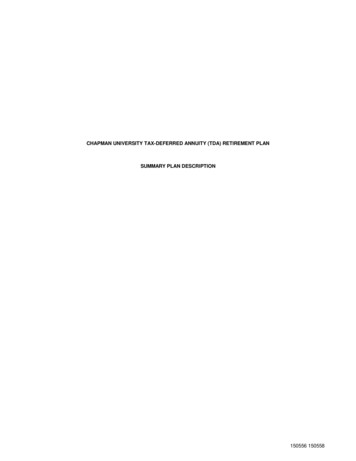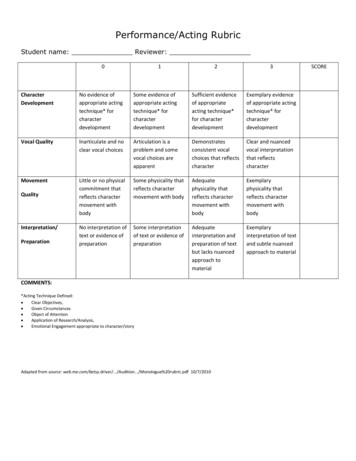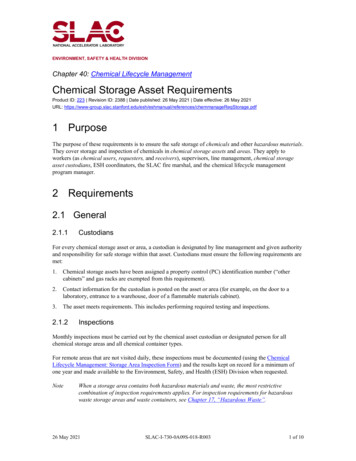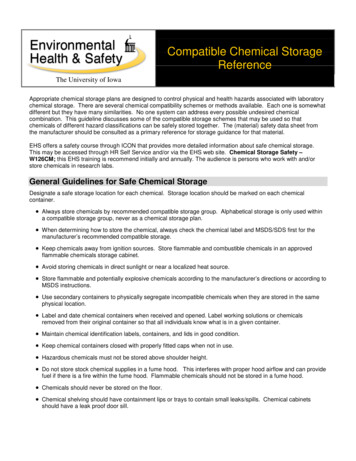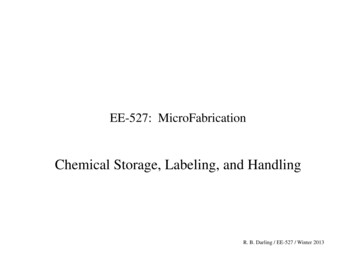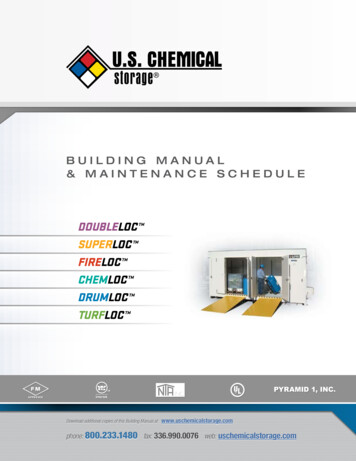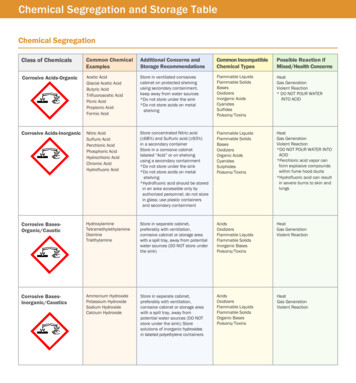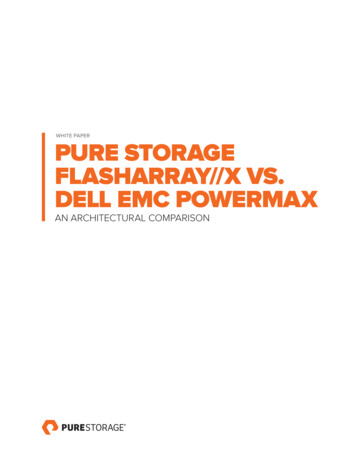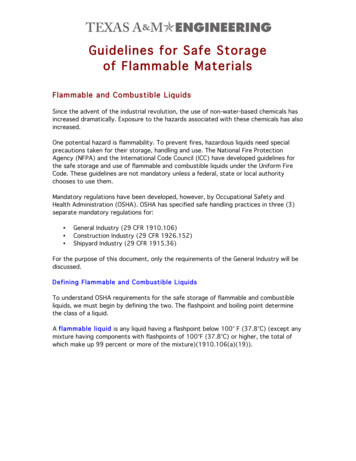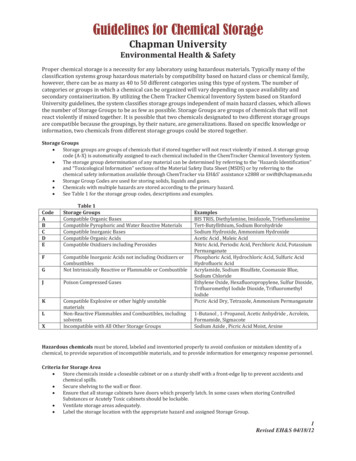
Transcription
Guidelines for Chemical StorageChapman UniversityEnvironmental Health & SafetyProper chemical storage is a necessity for any laboratory using hazardous materials. Typically many of theclassification systems group hazardous materials by compatibility based on hazard class or chemical family,however, there can be as many as 40 to 50 different categories using this type of system. The number ofcategories or groups in which a chemical can be organized will vary depending on space availability andsecondary containerization. By utilizing the Chem Tracker Chemical Inventory System based on StanfordUniversity guidelines, the system classifies storage groups independent of main hazard classes, which allowsthe number of Storage Groups to be as few as possible. Storage Groups are groups of chemicals that will notreact violently if mixed together. It is possible that two chemicals designated to two different storage groupsare compatible because the groupings, by their nature, are generalizations. Based on specific knowledge orinformation, two chemicals from different storage groups could be stored together.Storage GroupsxStorage groups are groups of chemicals that if stored together will not react violently if mixed. A storage groupcode (A-X) is automatically assigned to each chemical included in the ChemTracker Chemical Inventory System.xThe storage group determination of any material can be determined by referring to the “Hazards Identification”and “Toxicological Information” sections of the Material Safety Data Sheet (MSDS) or by referring to thechemical safety information available through ChemTracker via EH&S’ assistance x2888 or swift@chapman.eduxStorage Group Codes are used for storing solids, liquids and gases.xChemicals with multiple hazards are stored according to the primary hazard.xSee Table 1 for the storage group codes, descriptions and examples.CodeABCDEFTable 1Storage GroupsCompatible Organic BasesCompatible Pyrophoric and Water Reactive MaterialsCompatible Inorganic BasesCompatible Organic AcidsCompatible Oxidizers including PeroxidesGCompatible Inorganic Acids not including Oxidizers orCombustiblesNot Intrinsically Reactive or Flammable or CombustibleJPoison Compressed GasesKCompatible Explosive or other highly unstablematerialsNon-Reactive Flammables and Combustibles, includingsolventsIncompatible with All Other Storage GroupsLXExamplesBIS TRIS, Diethylamine, Imidazole, TriethanolamineTert-Butyllithium, Sodium BorohydrideSodium Hydroxide, Ammonium HydroxideAcetic Acid , Maleic AcidNitric Acid, Periodic Acid, Perchloric Acid, PotassiumPermanganatePhosphoric Acid, Hydrochloric Acid, Sulfuric AcidHydrofluoric AcidAcrylamide, Sodium Bisulfate, Coomassie Blue,Sodium ChlorideEthylene Oxide, Hexafluoropropylene, Sulfur Dioxide,Trifluoromethyl Iodide Dioxide, TrifluoromethylIodidePicric Acid Dry, Tetrazole, Ammonium Permanganate1-Butanol , 1-Propanol, Acetic Anhydride , Acrolein,Formamide, SigmacoteSodium Azide , Picric Acid Moist, ArsineHazardous chemicals must be stored, labeled and inventoried properly to avoid confusion or mistaken identity of achemical, to provide separation of incompatible materials, and to provide information for emergency response personnel.Criteria for Storage AreaxStore chemicals inside a closeable cabinet or on a sturdy shelf with a front-edge lip to prevent accidents andchemical spills.xSecure shelving to the wall or floor.xEnsure that all storage cabinets have doors which properly latch. In some cases when storing ControlledSubstances or Acutely Toxic cabinets should be lockable.xVentilate storage areas adequately.xLabel the storage location with the appropriate hazard and assigned Storage Group.1Revised EH&S 04/18/12
Guidelines for Chemical StorageChapman UniversityEnvironmental Health & SafetyOrganizationxOrganize chemicals first by compatibility not alphabetically.xOnly store in alphabetical order once chemicals are in appropriate storage groups.xLarger chemical containers should be stored towards the back and smaller ones should be stored up front wherethey are visible.Chemical ContainersxMust be clearly labeled and in good condition.xLabeled with purchase date, room, location and shelf number.xChemicals stored in non-manufacturer containers must have full chemical name and hazard listed.xShould be in good condition-showing no signs of oxidation (no leaking, cracked caps, rusting, nor have anycrystals around their necks.)Secondary ContainmentxUsed to separate incompatible chemicals.xShould be used for ALL liquid chemicals.xMust have the capacity to hold the amount of materials to be contained.xMust be capable of holding any spilled material until the spill can be cleaned up.xMust be compatible with the chemical stored. For example Hydrofluoric acid should be stored in a secondarycontainer constructed of polyethylene.Chemical Storage and SegregationxSeparate liquids from solids.xWhen possible utilize separate cabinets for storage groups.xWhen space does not allow storage groups to be stored separately from each other, multiple groups can bestored on the same shelf or within the same storage cabinet if each group is segregated by secondarycontainment as outlined in the diagram below.Note: Group J is not currently stored at this time. Contact EH&S x2888 or swift@chapman.edu prior to purchasingmaterials for the following groups: J, K and X. Examples of other materials which should be stored separately would beAcutely/Severely Toxic, Select Carcinogens and Reproductive Toxins along with any Controlled Substances.2Revised EH&S 04/18/12
Guidelines for Chemical StorageChapman UniversityEnvironmental Health & SafetyTable 2 below lists some examples of chemicals for the different Storage GroupsTable 2ChemicalGroup1-Butanol or 2L1-PropanolL2-MercaptoethanolLAcetic Acid, Glacial (flammable)DAcetic rylamideAgaroseAmmonium AcetateAmmonium ChlorideAmmonium FormateAmmonium HydroxideAmmonium NitrateAmmonium PersulfateAmmonium SulfateAmmonium SulfideBenzeneBIS & BIS-AcrylamideBIS TRISBoraxBoric AcidCalcium ChlorideChloroformChromergeCitric AcidCoomassie BlueDextroseDichloromethaneDiethylamine (flammable)LLLLLGGGGGCEEGLLGAGGGGEDGGGADiethyl PyrocarbonateDimethyl PopopDimethyl Sulfoxide (DMSO)LGLDrieriteEcoLume, UniverSOL, BetaMax,CytoScint, Scintisafe, Econo-Safe,Ecoscint, Opti-fluorEDTA (in solution G)EthanolEthanolamineEthersEthidium BromideEthyl AcetateEthylene Formic Acid (88%)GeopenGlutaraldehydeGlycerolGlycineGuanidine HydrochlorideGuanidine ThiocyanateHalothane, IsofluraneHEPESHexanesHydrochloric AcidHydrogen Peroxide, 90%Hydrogen Peroxide, 5%ImidazoleIsobutyl AlcoholIsopentaneIsopropanolMagnesium ChlorideMagnesium SulfateMaleic AcidMethanolN-Methyl-2-PyrrolidoneN,N DimethylformamideNitric AcidP-DioxaneParaformaldehydePerchloric AcidPeriodic AcidPermountPhenolPhosphoric AcidPicric Acid dry ( 10% H O)GroupGLLDGGLGGCGGLFEGALLLGGDLLLELLEELLFK2Picric Acid moist (10-40% H O)XPicric Acid soln (1-4%)PiperidinePipes, Free AcidPotassium AcetatePotassium ChloridePotassium CyanidePotassium Hydroxide (KOH)XAGGGCCPotassium PhosphatePPOPropionic AcidGGD2ChemicalGroupPropylene OxideLPump OilLPyridineASDS (Sodium Lauryl Sulfate) (inLsolution G)SigmacoteLSodium AcetateGSodium AzideXSodium BicarbonateGSodium BisulfateGSodium BisulfiteGSodium BorateGSodium BorohydrideBSodium Carbonate, AnhydrousGSodium ChlorateSodium Chloride (NaCl)Sodium Citrate, DihydrateEGGSodium Dichromate, DihydrateESodium Hydroxide (NaOH)CSodium HypochloriteSodium Hypochlorite solution (i.e.Bleach)Sodium PhosphateSodium Sulfide, AnhydrousSuccinic AcidSucroseSulfuric AcidTannic AcidTEMEDTES free acidTetracyclineTetrahydrofuranTrichloroacetic AcidTolueneTriethanolamineTRISTriton X-100TrizolTWEEN 20UreaWD-40XylenesZinc ChlorideEGGBDGFDAGGLDLAAGLGGLLG3Revised EH&S 04/18/12
Guidelines for Chemical StorageChapman UniversityEnvironmental Health & SafetyPracticesxMaterials and their containers should be inspected routinely, a minimum of 6 months per the City of Orange FireDepartment.xIndications for disposal include:o Cloudiness in liquidso Material changing colorso Evidence of liquid in solids or solid in liquidso Signs of container leakageo Indication of pressure build up within containero Obvious container deteriorationo Peroxide formation or oxidationxEvery chemical should have an identifiable storage place and should be returned to that designated storagegroup location after each use.o After each use, carefully wipe down the outside of the container with paper towel.xxxxxNever store chemicals from different Storage Groups in the same container.Chemical containers should be turned with the labels facing out so they can be easily read.Chemicals should not be stored above eye level and when practical store on lower shelves.Avoid storing chemicals on the floor or under sinks.Chemical storage in hoods should be minimized to avoid blocking rear baffles and interfering with airflow intothe hood.Chemical storage on bench tops should be minimized in order to reduce the amounts of chemicals unprotectedfrom a potential fire and to prevent them from being easily knocked over.Do not store chemicals in offices, domestic or personal refrigerators.Inventory the materials stored in the refrigerator frequently and defrost occasionally to prevent chemicals frombecoming trapped in the ice formations.Although the City of Orange Fire Department set chemical storage limits on all chemical classifications, theirprimary focus is concerning flammable liquids, flammable gases and Extremely/Acutely/Severally Toxicmaterials.Physically inventory all chemicals on an annual basis and update ChemTracker data base as soon as possible forany additions, deletions or any changes including the room, location and shelf locations.oEH&S must be notified immediately about any changes regarding compressed gas cylinders ormaterials in Group X per City of Orange Fire Department requirements.oOnce all chemical inventories are reviewed which must take place on an annual basis, EH&S willprovide a copy of the Storage Groups and hazards classes for each room. This list will be maintainedin the Laboratories “Laboratory Procedures and Safety Manual.”xxxxxStorage Group-Specific RequirementsxCorrosive (Group A,C,D and F)oStore corrosive chemicals in dedicated corrosion resistant and ventilated cabinets whenever possible.oSecondary containment must be used when storing acids on bare metal.oOrganic acids (Group D), such as Acetic acid, Lactic acid, and Formic acid (Group D), are consideredcombustible and corrosive and can be stored in flammable storage cabinets.oDo not store acids near any cyanide or sulfide containing chemicals in order to prevent the generationof highly toxic hydrogen cyanide or hydrogen sulfide gases.oDo not store concentrated acids next to household bleach, as mixing will generate highly toxic chlorinegas. When stored next to ammonium hydroxide, any potential mixing will generate highly toxicchlorinated amine gases.4Revised EH&S 04/18/12
Guidelines for Chemical StorageChapman UniversityEnvironmental Health & SafetyxWater-Reactive and Pyrophoric (Group B)oWater reactive chemicals must be stored in a closed water-tight container and in a manner to preventdirect contact from water (i.e., not under sinks or on open shelving) and for those stored in thebasement away from fire sprinkler systems.oThey should be segregated from any corrosives and aqueous liquids.oThe storage area for water-reactive chemicals must be labeled “Water-Reactive Chemicals.”oPrevent pyrophoric chemicals from contacting air by taking extreme care to prevent containers fromleaking or breaking. For additional protection, consider keeping the chemicals in the manufacturer’soriginal shipping package (i.e., surrounded by vermiculite inside a metal can).xOxidizers ( Group E)oDo not store oxidizing acids (such as perchloric acid, nitric acid) on wooden shelves or in cardboardboxes.oSegregate oxidizing acids (Group E) (nitric, perchloric, chromic acid, chromerge) from organic acids(acetic, formic, etc.) to prevent fires.xFlammable (Group L)o Store flammables in approved storage cabinets or in safety cans.o The capacity of glass containers shall not exceed one (1) gallon. Metal containers are required forstorage of flammable liquids exceeding one gallon.o The capacity of a container shall not exceed one liter when stored outside of a cabinet.o A maximum of ten (10) gallons of flammable/combustibles materials/wastes may be stored outside ofapproved flammable storage cabinets per zone. Zone 1 Rooms 406 and 412 Zone 2 Rooms 403, 219 and 428 Zone 3 Rooms 404, 427 and 439 Zone 4 not including room 300 and the balance of the floor area Room 128 is excluded since it is designed and maintained in accordance with therequirements of an approved liquid storage room The basement is its’ own separate area Storage limitations for liquids is based on the following classificationsoooooTermClassFlash ibleCombustibleIAIBICIIIIIAIIIBδ Ǐδ Ǐ Ǐ ͳͲͲ Ǐ ͳͶͲ Ǐ ʹͲͲ ǏBoiling PointRatingδͳͲͲǏ ͳͲͲǏ δͳͲͲǏ εͳͲͲǏ δͳͶͲ ǏδʹͲͲ ǏNFPA433221Keep away from all ignition sources such as open flames, hot surfaces, direct sunlight and spark.Flammable materials or gases are prohibited from use in the basement.Store in vented flammable cabinets whenever possible (e.g. under hoods).Explosion-proof or flammable-proof refrigerators must be utilized when flammable liquids must berefrigerated. The use of standard/domestic refrigerators to store flammable liquids is prohibited.Peroxide-forming chemicals are typically classified as Flammables (Group L). In addition to theflammable specific storage requirements, peroxide-forming chemicals must meet the followingrequirements Write the date received, opened and expired on all containers. Store in airtight containers in a dark, cool, and dry place. Do not store
chemical safety information available through ChemTracker via EH&S’ assistance x2888 or swift@chapman.edu xStorage Group Codes are used for storing solids, liquids and gases. xChemicals with multiple hazards are stored according to the primary hazard. xSee Table 1 for the storage group codes, descriptions and examples. Table 1

